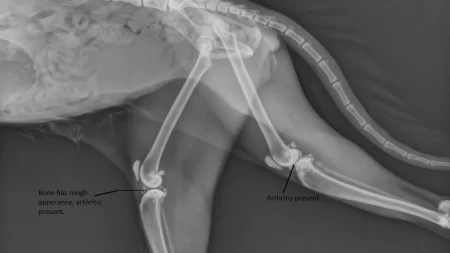Several effective methods exist for eliminating fleas on a cat’s face. Apply a drop of flea shampoo or dish soap to a fingertip and gently massage the cat’s face, taking care to avoid eyes and nostrils.
Give your cat a Capstar pill or bathe it in Dawn dish soap before providing medication for added effectiveness.
Use warm water and either a fragrance-free dish liquid or natural baby shampoo during the bath.
Proceed to remove fleas and eggs with a flea comb. Sprinkle dried rosemary powder in areas where fleas commonly congregate.
Armed with these useful suggestions, pet owners can confidently address fleas on their cat’s face.
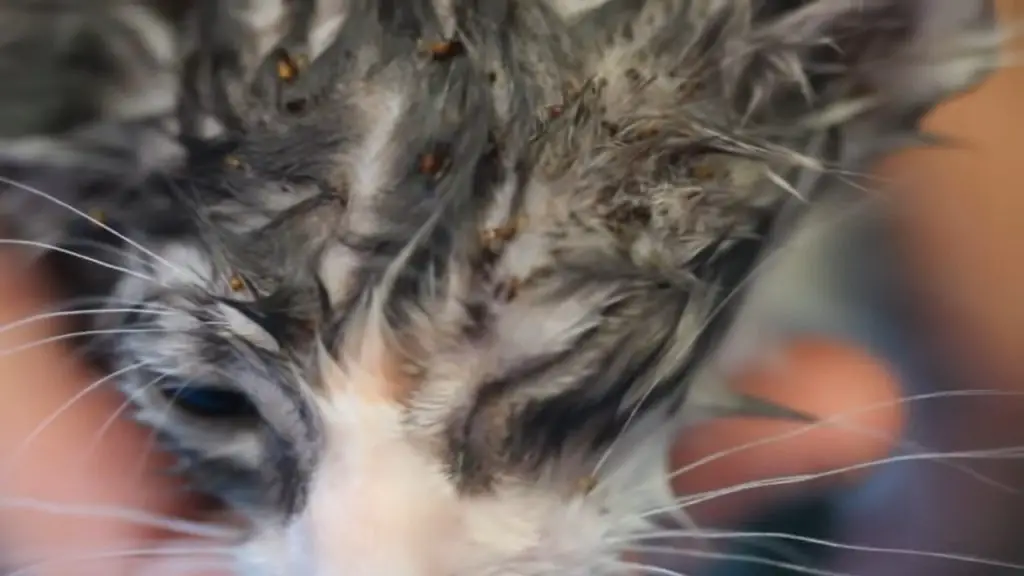
Fleas are small, dark-brown parasites between 1/12” and 1/6” long. The flea’s life cycle is complex but generally follows this order: egg; larva; pupa; adult. Adult female fleas lay their eggs on the fur of a host animal while feeding on its blood; most eggs fall off where they soon hatch in warm temperatures (18° C – 30° C). Larvae feed on dirt or feces of adult fleas before spinning a cocoon where it will emerge as an adult looking for an animal to feed from – repeating the cycle over again.
Cats with abundant facial hair are more vulnerable to fleas, as it provides ideal conditions for them to hide and disperse quickly once disturbed. You should check your cat’s face regularly if you think your pet may be suffering from a severe flea infestation – the presence of small, red bumps is a symptom your cat has been bitten by fleas. Those bites will be intensely itchy for cats and may lead to inflammation, which could further spread infection and diseases through scratching.
The Lifecycle of a Flea
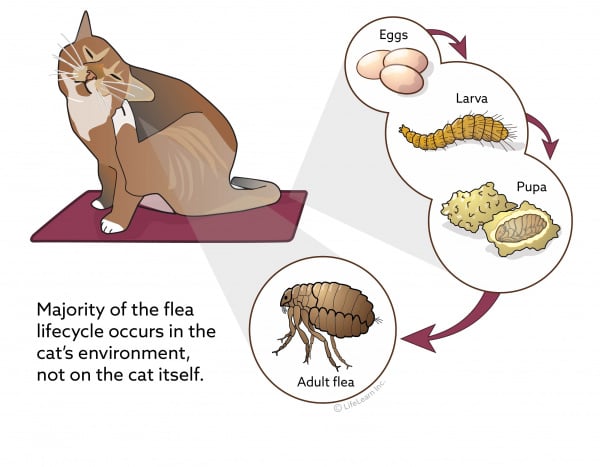
The life cycle of a flea consists of four stages: egg, larva, pupa, and adult.
Egg
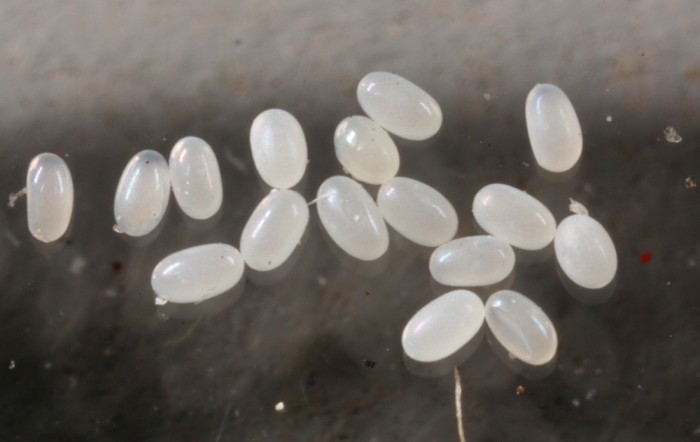
Fleas lay their eggs on the host animal (such as a cat or dog). The eggs are small and white, and they can easily fall off of the animal and into the environment, where they can hatch into larvae.
Larva
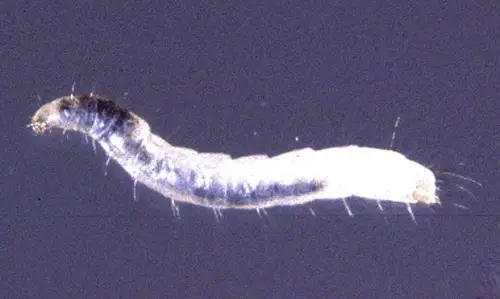
The larva is the second stage of the flea’s life cycle. Flea larvae are small, worm-like creatures that feed on organic matter, including flea feces and debris. They do not have legs, and they cannot move very far.
Pupa
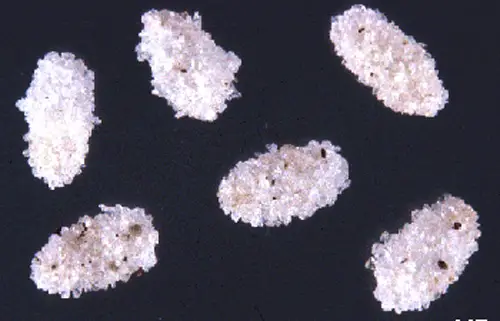
After several days or weeks, the larva spins a cocoon and pupates (enters the pupal stage). The pupal stage is a resting stage, and the flea remains inside the cocoon until it is ready to emerge as an adult.
Adult
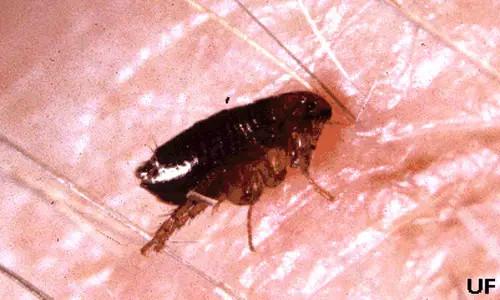
Once the flea has completed the pupal stage, it emerges as an adult. Adult fleas are small, reddish-brown insects that are flattened from side to side. They have long legs and are capable of jumping great distances, which helps them quickly locate a host animal. Adult fleas feed on the blood of their host, and they are capable of reproducing within a few days of feeding.
Symptoms of Fleas on Cat’s Face
Fleas on cats can cause a wide variety of symptoms, and they can range from minor to severe. Some effects that may be visible on a cat’s face include itching, redness, bumps or lesions, and excessive grooming. If your cat has fleas, they may also present with a rough coat texture.
Itching is the most common symptom of a flea infestation on your cat’s face. Excessive scratching of the area can result in skin irritation and even hair loss in extreme cases. Additionally, fleas will often leave behind small red or raised bumps which are easily visible to the naked eye. These itching issues may also look like sores or lesions which worsen over time if left untreated.
Finally, excessive grooming is another common sign that your cat has come into contact with fleas on their face or other parts of their body. This behavior is caused by an allergic reaction to the saliva from the flea bite which causes inflammation and discomfort. As a result, cats will often groom themselves excessively in that area until they are relieved of this discomfort – leading to further skin irritation if left unchecked.
Diseases Caused by Fleas on Cat’s Face
Fleas on a cat’s face transmit a wide range of infectious diseases, including bacterial and viral illnesses. flea-transmitted diseases often manifest in the form of skin problems including anemia, mange, tapeworms, and fur loss. Some fleas, such as the Cat Flea (Ctenocephalides felis), can also be vectors of dangerous viruses and bacteria that can cause serious health problems in cats, such as the feline leukemia virus (FeLV). For this reason, it is vital to recognize fleas on your cat’s face early on so that an effective treatment plan can be put into place and the disease symptoms can be treated.
Flea-borne bacteria can cause severe pyoderma and skin infections in cats if left untreated for too long. Pyoderma symptoms include excessive scratching and licking, inflamed skin lesions or pustules, and hair loss around the ears or face. Mites carry parasitic worms that if left untreated can lead to anemia or even death in extreme cases due to blood loss. Other common parasites carried by fleas are tapeworms which can also cause serious health issues. If you recognize signs of any of these diseases on your cat’s face it is important to contact your veterinarian as soon as possible for diagnosis and treatment.
Fleas on cats are more than just an irritating nuisance; they pose a considerable health risk for cats with cat-flea-borne diseases being one of the most common illnesses affecting our four-legged friends. It is therefore extremely important to keep vigilant when checking for pesky fleas during regular grooming sessions so that you are able to take the necessary steps to care for your feline friend before any further damage is caused by these pesky pests!
Prevention of Fleas on Cat’s Face
When looking to prevent fleas from infesting your cat, there are a few things you can do. Vacuuming and steam cleaning can help remove flea eggs and larvae from your home, while also helping to eliminate allergens. Treating your pets with regular flea and tick products is essential in maintaining their health. These products are available in topical or oral forms and should be administered monthly or as per the manufacturer’s instructions. Washing bedding that may be frequently used by pets will also help avoid an infestation as fleas like to live in warm, dark places such as mattresses or furniture cushions.
Cats with access to the outdoors can bring fleas into the home on their fur or by preying on other animals. Doing a routine check of your pet’s coat for any signs of fleas is important, especially if your cat has been outside for an extended amount of time. If you do notice signs of a flea infestation, take swift action immediately so it does not spread further. Consulting with a vet is the best practice as they will know what solutions are available for treating the issue at hand quickly and safely depending on the type of infestation occurring in your cat’s fur/coat.
Treatment of Fleas on Cat’s Face
Treating and preventing flea infestations in cats is essential for keeping your feline pet healthy, comfortable, and free of infection. Depending on the severity of the infestation, fleas can be removed manually or with chemical products specifically made to control, repel, and kill fleas.
Manual Removal
To manually remove fleas from your cat’s coat and face, use a pair of tweezers to pluck them out one by one. Place them in a bowl filled with hot soapy water, which will drown them. Regularly comb through your cat’s coat in order to check for any remaining fleas hiding among their fur.
Chemical Products
There are numerous products available to help control infestations of fleas on cats, including spot-on treatments (topically applied), shampoos/conditioners you can bathe your cat in, collar applicators designed for cats, oral medications dispensed from food bowls and powders that are sprinkled onto fur or carpets where they may reside.
When using chemical products on cats it is important to choose those specifically tailored to felines as most human-based and canine treatments may be toxic if used inappropriately on cats. Follow all directions carefully when using these products as indicated by the manufacturer’s instructions; dosages and applications vary by age/breed/size/type of animal being treated.
Environmental Treatments
Fleas can reproduce inside the home as well as living on your pet’s body – so it is also important to treat environmental areas where they often hide or lay eggs such as carpets, bedding, furniture, or hardwood floors.
- Vacuum often along with steam cleaning carpets regularly (reapply stain preventer afterward).
- Wash bedding in hot water weekly; use IGRs (insect growth regulators) around baseboards & furniture.
- Discard used vacuum bags immediately after use.
- Treat yard & other outdoor areas with approved insecticides specific for flea control.
- Avoid foggers that contain flammable ingredients like butane or propane gas because these can be very dangerous if not used correctly under proper ventilation – instead opt for natural alternatives such as cedar chips & diatomaceous earth (DE) both of which can help rid indoor areas of adult & larval stages of certain insects without introducing toxins into the environment or posing a risk of fire hazard caused by heavier & inappropriately used chemicals inside tightly sealed homes without proper ventilation setup along with safety equipment present while application occurs while occupants are absent elsewhere during this process.
WARNING – if you suspect an acute problem consult an exterminator before taking action!
Home Remedies for Fleas on Cat’s Face
Some home remedies to help ease flea symptoms on your cat’s face can be useful. It is important to never use over-the-counter products or home remedies intended for humans on cats – and always consult with a vet before trying any home remedies.
Bathe

Gently bathing your cat with lukewarm water and gentle soap can help reduce the itching caused by flea saliva. To prevent the water from running into their eyes, ears, and nose, use cotton wool balls in each of those areas while you bathe. This should also help reduce the irritation caused by fleas on their face.
Apple Cider Vinegar
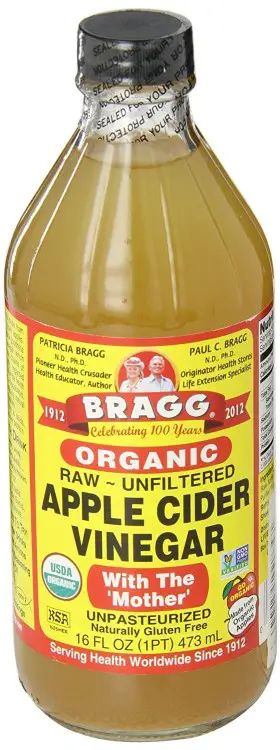
Applying apple cider vinegar to your pet’s coat can both repel fleas and provide relief from itchy bites that were already present before treatment.
Baking Soda Paste
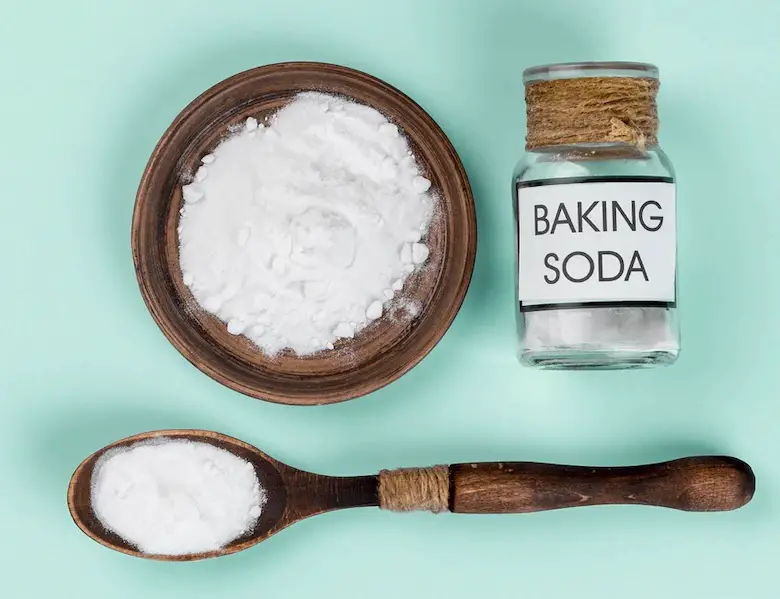
For persistent cases, baking soda can be applied directly to your cat’s fur as a paste or compress. The baking soda should provide some relief from irritation due to its anti-inflammatory qualities.
Vaseline Treatment
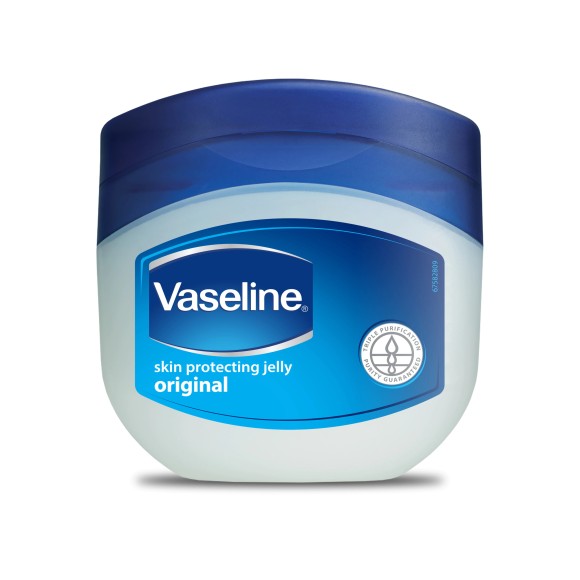
Covering affected areas with petroleum jelly can help cut through existing eggs laid by the fleas, thus helping to reduce the number of larvae they are exposed to in the future due to them not being able to make contact with skin again in order to reproduce successfully. This method should ideally be followed up by the use of a de-wormer specifically designed for cats as protozoa such as coccidia and toxoplasmosis are common carriers of cat parasites that may have been unknowingly passed onto them by these pests.
Professional Care for Fleas on Cat’s Face
If you have discovered fleas on your cat’s face, it is important to see a veterinarian to get the correct diagnosis and treatment plan. The goal of any flea infestation treatment is to kill the existing larvae and adult fleas, as well as to prevent re-infestation. A vet may use medications that are either systemic or topical products that must be applied every two to four weeks, depending on what type you choose.
Systemic medications are injected under the skin and circulate through your cat’s bloodstream to target fleas and other parasites which prevent them from entering the cat. Topical treatments are available in liquid or spray formats that can be directly applied on your pet’s skin between their shoulders for prevention against fleas. Furthermore, a vet may also recommend medicating the pet’s environment with Flea Collar such as non-toxic insecticides and controlled hazardous substances such as IGR (insect growth regulators).
A vet typically will take a fecal sample of your pet during its physical exam which allows them to accurately diagnose if there is an internal problem caused by the parasites, such as tapeworms. In addition, vets will give recommendations on how to keep your home clean from further infestations by vacuuming furniture, carpets, and other areas fleas could hide, in addition to washing coats and bedding regularly at high temperatures for the most effective results.
6 Most Important Tips You Must Know
If you suspect that your cat has fleas, it’s important to take action as soon as possible to treat the fleas and prevent them from spreading. Here are some tips for dealing with fleas on your cat’s face:
Consult with a veterinarian
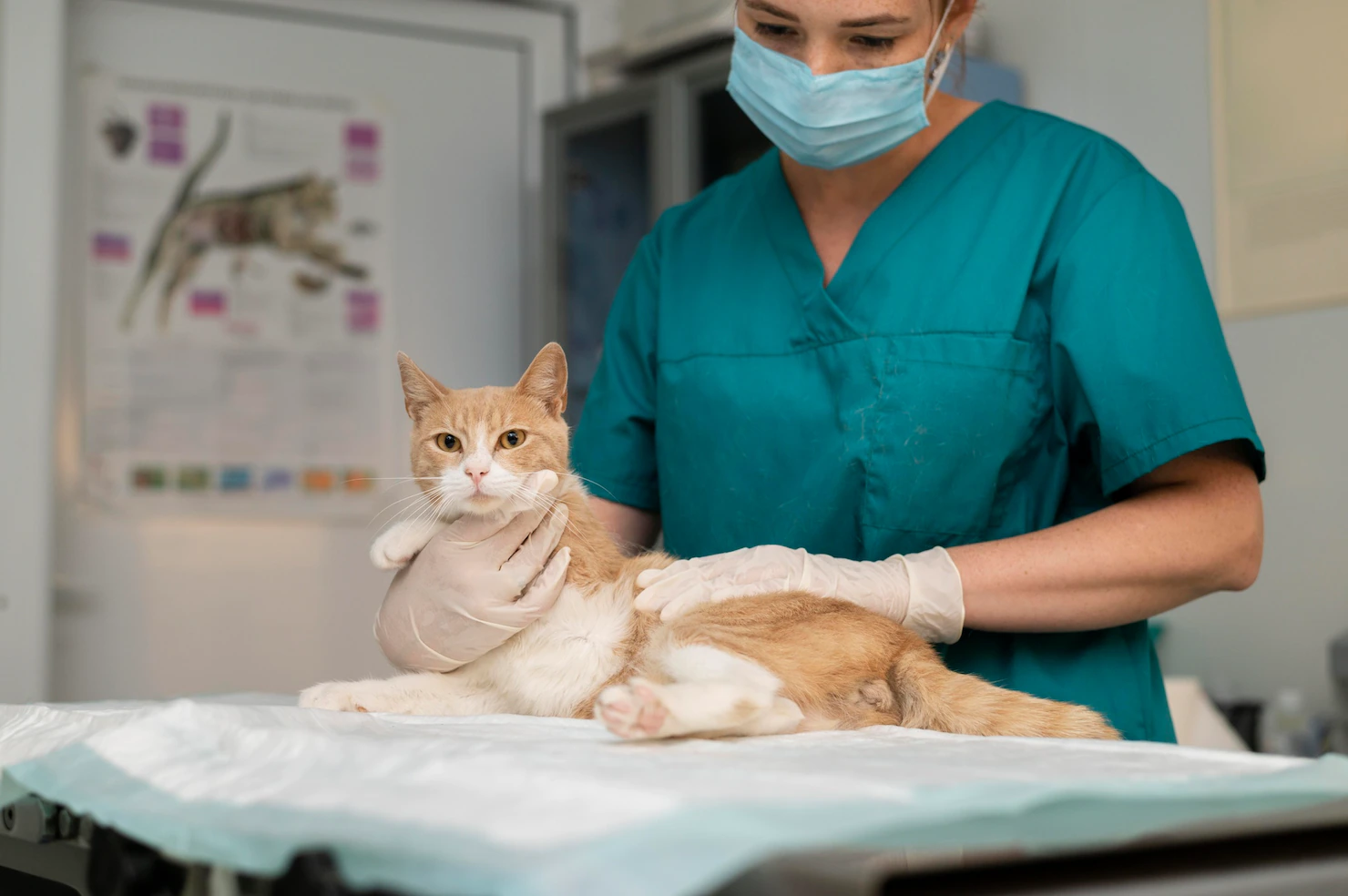
Your veterinarian can recommend a safe and effective flea treatment for your cat. Some treatments may be applied directly to the skin, while others may be given orally.
Use a flea comb
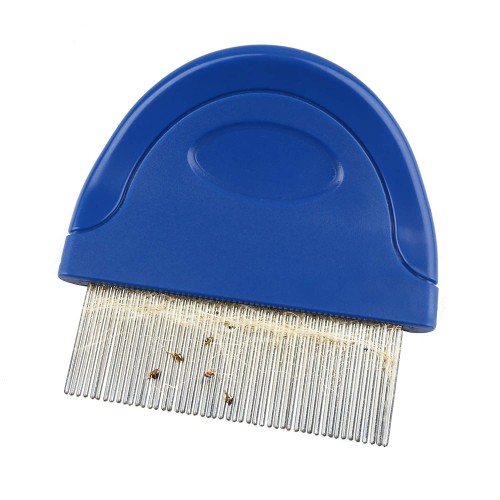
A flea comb is a fine-toothed comb specifically designed to remove fleas and their eggs from your cat’s fur. Use the comb to gently comb through your cat’s fur, paying special attention to the face and neck.
Wash your cat’s bedding
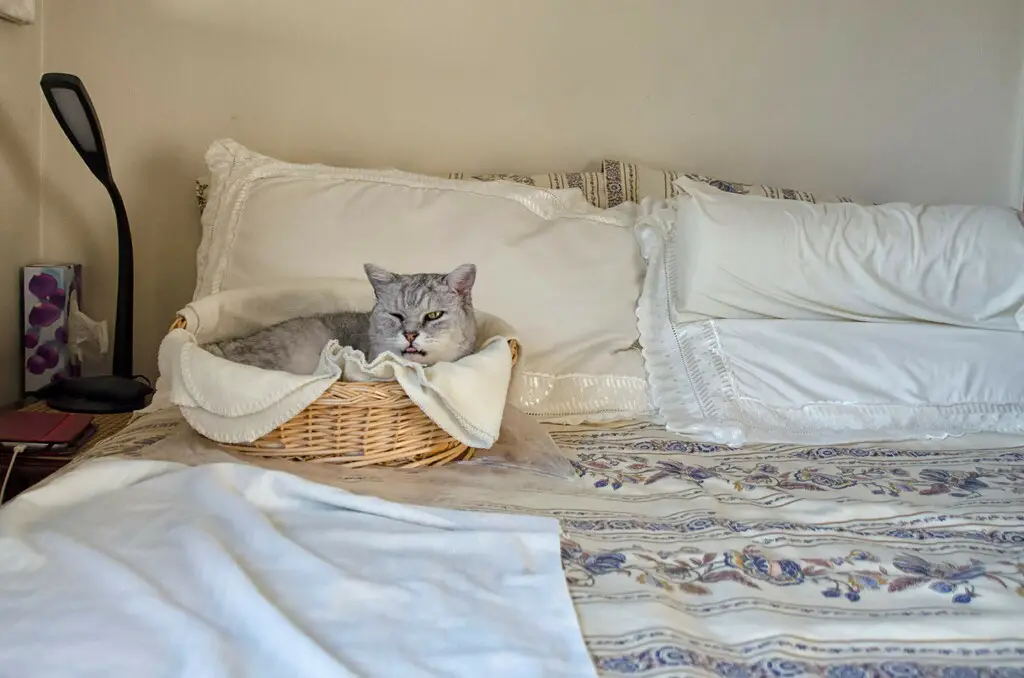
Fleas and their eggs can accumulate in your cat’s bedding, so it’s important to wash all of your cat’s bedding in hot water to kill any fleas or eggs that may be present.
Vacuum your home regularly
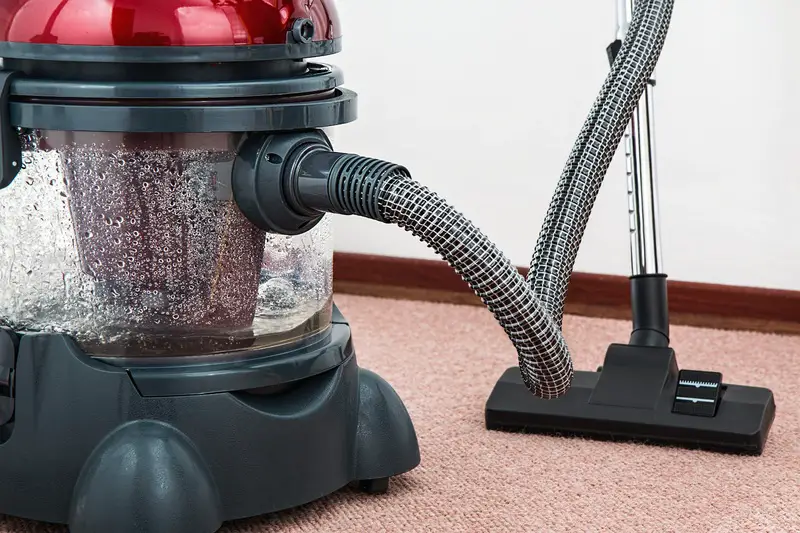
Vacuuming can help to remove fleas and their eggs from your carpets and upholstery. Be sure to dispose of the vacuum bag after each use to prevent the fleas from escaping.
Treat your home for fleas
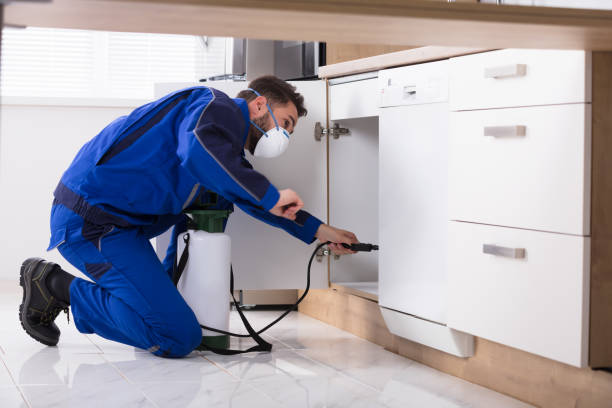
In addition to treating your cat for fleas, you may also need to treat your home for fleas to fully get rid of the infestation. There are a variety of flea control products available for use in the home, including sprays, powders, and foggers.
Prevent future infestations
To prevent future infestations, it’s important to keep your cat’s environment clean and to use a flea preventive on a regular basis. Your veterinarian can recommend a preventive that is suitable for your cat.
Conclusion
In order to avoid putting your cat at risk of flea infestation, it’s important to adopt a few preventative measures. Make sure you maintain a regular flea prevention program for your cat, such as monthly treatments with a topical or oral flea product. Keep your lawn and garden clipped and weeds controlled, as well as wash or replace your pet’s bedding often. Lastly, keep your home clean and vacuum carpets often to help reduce the chances of a flea infestation in your home.
Fleas are an uncomfortable nuisance for cats but with the right care from their owners, cats can be kept safe from many of the health risks associated with having fleas in the home. With regular care and preventative measures in place, you can ensure that your cat is getting the best possible protection against fleas and other parasites.
FAQs
Where do fleas like to hide on cats?
Fleas tend to hide in areas where they can easily access the skin of their host animal, such as around the neck, behind the ears, and on the belly.
Can you get rid of fleas by bathing your cat?
Bathing your cat may help to remove fleas from the surface of their fur, but it is not a reliable method for getting rid of fleas. Fleas can quickly re-infest a cat, and the eggs and larvae can survive in the environment. To effectively get rid of fleas, it is important to use a combination of treatments, including flea control products and environmental controls. Consult with a veterinarian for recommendations on the best treatment options for your cat.
Does shaving help with fleas?
Shaving your cat’s fur may make it easier to spot and remove fleas, but it is not a reliable method for getting rid of fleas.
Resources:






